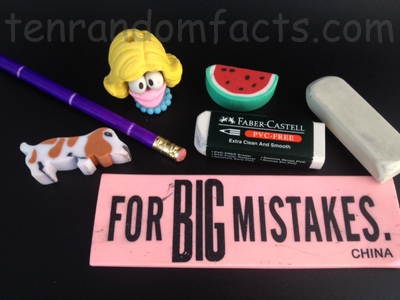Do erasers ever rub you the wrong way?
- Erasers are inventions used to clear markings from an object, which is most often paper, and before they were invented, wax, bread, a mixture of oat bran and milk, pumice or sandstone were used to remove markings from a writing surface.
- An ‘eraser’, once called a ‘lead-eater’, is also known as a ‘rubber’, which was the original term for the object due to the rubbing motion required to use it, while the natural material caoutchouc also became known as ‘rubber’ due to its use as an erasing tool.
- The type of markings commonly removed by a rubber are those made with a pencil, generally graphite, although, ink, chalk and whiteboard pen marks are also able to removed with an appropriate eraser.
- The base material of erasers is generally synthetic or natural rubber, plastic, vinyl or gum, although felt and other fibres are used for those that have the purpose of clearing whiteboard markers and chalk.
- The discovery of caoutchouc or rubber as a useful tool for erasing, was made in the mid 1700s, and in 1770, Englishman Joseph Priestly, a scientist and theologian is said to have named the ‘eraser’, which was a later American term for the tool, a ‘rubber’.
- Erasers vary in colour, and are commonly white, but can range from pink to grey, and are typically found in a bar shape or as a cylinder on the end of a pencil, while some come in a kneadable or electric form.
- Most rubber erasers undergo the process of vulcanisation, which was discovered in 1839 by American chemist Charles Goodyear, which significantly increases the rubber’s usability and long lasting nature.
- The modern eraser, although unvulcanised at the time, is believed to have been primarily commercialised by Englishman Edward Nairne, an optician, in 1770, when he was selling cubes of rubber for the purpose of erasing.
- Erasers generally remove markings, such as graphite, by collecting the marking’s particles in the rubber’s compound, as the rubber has greater adhesive properties than the erased surface.
- Erasers can come in a wide variety of different shapes, sizes and colours that are commonly collected, although these more collectible orientated rubbers generally erase poorly.
Bibliography:
Eraser, 2015, How Products Are Made, http://www.madehow.com/Volume-5/Eraser.html
Eraser, 2015, Wikipedia, http://en.wikipedia.org/wiki/Eraser
Garber M, 10 Things You Probably Did Not Know About Eraser Technology, 2013, The Atlantic, http://www.theatlantic.com/technology/archive/2013/08/10-things-you-probably-did-not-know-about-eraser-technology/279028/






